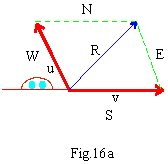|
EXAMPLE 4 : Determine the resultant of 26N,
100, 40N, 1150, 63N, 1880, 60N, 2600
Solution
By the Law of Polygon, place tail of each vector in turns at the arrow of the preceding vector.
 = Resultant = Resultant
\ | | = 70 N with qx = 2030 (obtained from the measurement of the figure) | = 70 N with qx = 2030 (obtained from the measurement of the figure)

EXAMPLE 5 : A car is traveling due east with the speed of 180 miles per hour. There is a storm, blowing in North west direction at 60 miles per hour. Draw a diagram that represents the car's speed and direction relative to the storm.
Solution
Let V be the velocity vector for car speed with | v | = 180 miles per hour due east.
Let u be the velocity vector for storm speed with |u| = 60 miles per hour due North west
The bearing of v is the angle measured from due north to v is
2700 and
The bearing of u is the angle measured clockwise from due north
150
Using tail- up rule, the length and bearing of the resultant calculated as by using Laws of
Cosine as
R2 = u2 + v2 - 2uv cos 450
R2 = ( 60 )2 + (180)2 - 2 (60) (180) cos 450
R2 = 3600 + 32400 - 2 (21600) (0.7071)
R2 = 20726.4935 \ R = 143.97 miles per hour.
Now using Sine Law, 


Thus the bearing angle = (90- 17.14)0 = 72.860
|